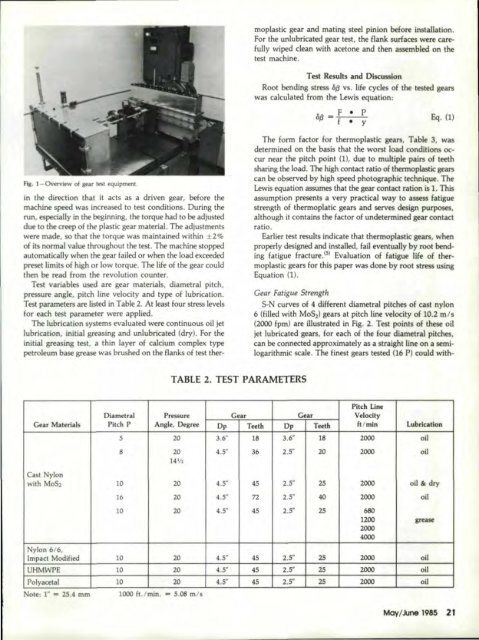Download PDF - Gear Technology magazine
Download PDF - Gear Technology magazine
Download PDF - Gear Technology magazine
You also want an ePaper? Increase the reach of your titles
YUMPU automatically turns print PDFs into web optimized ePapers that Google loves.
in the direction that it acts as a. driven gear, before the<br />
machine speed was increased to test conditions. During the<br />
run, especially in the beginning, the torque had to be adiusted<br />
due to' the creep .of the plastic gear material, The adjustments<br />
were made, so that ,the torque was, maintained within ±2%<br />
of its normal value thIoughout the rest. The machine stopped<br />
automarlcally when rhe gear failed or when the load exceeded<br />
preset limits of high or lew torque, The life ofthe gear could<br />
then be read from the revoluhon counter ..<br />
Test variables used are gear materials, dia.metraJ pitch,<br />
pressure angle, pitch line velocity and Itype of luhrication,<br />
Test parameters are listed in Table 2. At least four stress levels<br />
for each test parameter were applied.<br />
The Iuhricatlon systems evaluated were continuous oil jet<br />
Wub:r:ication, initial greasing and unlubricated (dry), for the<br />
:initial greasing test, a. Ithinlayer of calcium complex type<br />
petroleum base grease was brushed on the flanks of test thermoplastic<br />
gear and mating steel pinion before Installation.<br />
For the unlubricatedgear test, the f1ankwfaces, were carefully<br />
wiped dean with acetone and 'then assembled on 'the<br />
test machine.<br />
Test Results and D.iscu ion<br />
Root bending stress 0/3 vs. life cycles of the ~ested gears<br />
wascalculated from the Lewis equ.alion:<br />
f· P<br />
6{3 - ~f-.-"";y:"'"<br />
Eq. (1)<br />
F,ig. ]- 'Overview of ge r lest equipment,<br />
TheIorrn factor for thermoplastic gears, Table J, was<br />
determined on the basis that the worst load ,conditions oe-<br />
CUI near the pitch point (1), due to mul.tiple pairs of teeth.<br />
sharing the load. The high ,c~ntact ratic of thermoplastic gears<br />
can be observed by high speed photographic eechnique. The<br />
Lewis equation assumes Ithat the gear ,contact ration is 1. This<br />
assumption presents, a very practical way eo assess fa.tigu<br />
strength of thermoplatic gears andserves design purposes,<br />
although it contains the factor of undetennined gear contact<br />
ratio.<br />
Earlierl.est results indicate that thermoplastic gears, when<br />
properly designed and installed, fail ,eventually by root bending<br />
fatigue fracture. (5) Evaluation of fatigue life of thermoplastic<br />
gears for this paper was done by root stress using<br />
Equation (1).<br />
TABLE 2. TEST PARAMETERS<br />
<strong>Gear</strong> Fatigue Strength<br />
SoN curves of 4 different diametral pitches of cast nylon<br />
6 (filled with MoS 2 ) gears at pitch line velocity of 10..2.m/s<br />
(2000 fpm) are illustrated in Fig. 2. Test points of these oiW<br />
jet Wubrica'le,dgears, for each of the four dlametral pitches.<br />
can. be connected approximately as a straight line ona senlllogarithmic<br />
scale. The finest gears 'tested (16 P) could with-<br />
Pitch Lin-<br />
Diametral P.reS5ure <strong>Gear</strong> Ge.ar Velocity<br />
'<strong>Gear</strong> Mal.eri .•als PU.ch P .Mgl-, Oegr-ee' Op -r:~th Op Teeth Ifit/mln l.lIbrication<br />
Cas!<br />
Nylon<br />
5 20 3,6 n 18 3,6" 18 2000 oj]<br />
8 20 4S 36 2.5" 2-0 2000 oil<br />
14Vl<br />
I with MoSz 10 20 4S 45 2.5" 25, 2000 oil Ii: dry<br />
1.6 20 4.5" 72 2.5" 40 2000 011<br />
10 20 4.5" 45 2.5" 25 680'<br />
12·001 grease<br />
, 2000'<br />
I<br />
4.000<br />
I Nylon 6/6,<br />
I Impact Modified 10 20 4.5" 45 2.5" .25 2000 oil<br />
UHMWPE 10 20 4.5" 45 2;.5~ 2S 2000 aU<br />
Pelyacetal 10 20 4.5" 4S 2.5" 25 2000 ell<br />
Note: r ... 25.4 mm 1000 fl./min. -, 5.0B, m/s<br />
May/JUne 19,85, 21

















